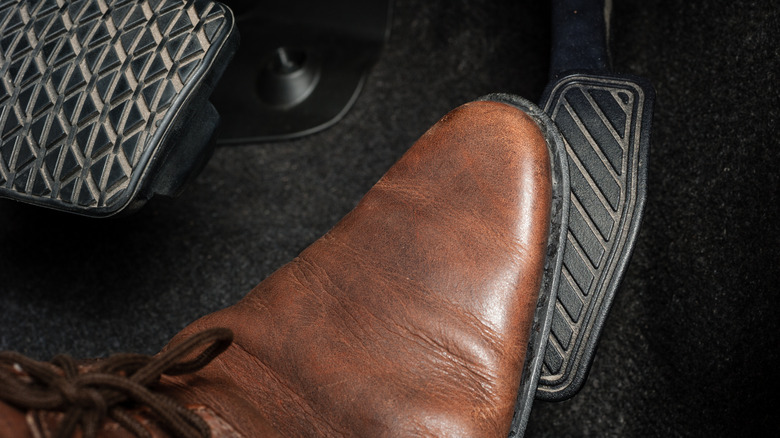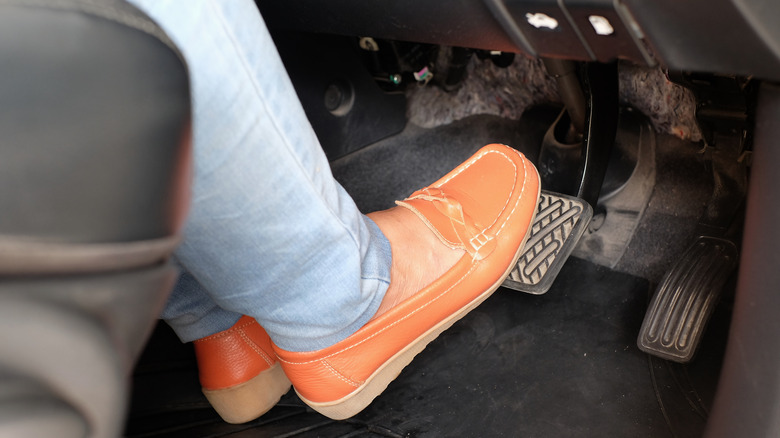What Are Driving Shoes, And Is It Worth Getting A Pair?
You may have heard of electric shoes, but what of driving shoes? These are meant to be worn while driving, and their design reflects this purpose: They are typically light and have raised rubber sections on the soles, which are extended beyond the very bottom of the shoe. The idea is to offer the best grip possible and the easy comfort to be worn in all weathers and conditions.
There's no denying that, when it comes to driving, safety is paramount. As a result, footwear matters. Driving in sandals or while barefoot isn't against the law in the United States, but the potential of a tragic slip is perhaps heightened in such cases. According to the RAC, the U.K.'s Driving Standards Agency reports that not wearing shoes behind the wheel reduces your ability to use your brakes efficiently.
Footwear that is heavy enough to do just that — but not so heavy as to affect the feedback received from the pedals — would seem to be the perfect compromise, and providing just that is the goal of driving shoes. Similarly, if you spend a lot of time outdoors or are otherwise liable to get your shoes very dirty over the course of your day, having some driving shoes ready and waiting in the car could be just the ticket. In this introductory guide, we'll take a brief look at the history of the driving shoe, and whether today's equivalents are worth the purchase.
The first driving shoes
The very first driving shoes were developed by the Italian Gianni Mostile and patented in 1963. These shoes were a perfect match for the driver who wanted to protect the interior of their vehicles, drive comfortably, and sport a not-so-subtle status symbol to boot. They weren't the greatest choices for longer walks, depending on the terrain in question, but that was precisely the point of calling them driving shoes.
The Italian company Tod's brought the car shoe — which it named the Gommino — to the worldwide market. No longer such expensive exclusives, they're now available in a range of colors and styles to allow any wearer to express themselves. Pilot's most popular options range from the $99 Slipstream Asphalts to the $225 Atlas Tans. In January 2024, the Icona from Piloti was announced. This new variety of driving shoe boasts a technology it deems Roll Control 2.0, again emphasizing the curved heel and rubber sole that is characteristic of such footwear.
It's clear, then, that the range and variety of driving shoes have widened considerably since Mostile introduced them, and they're also engineered with new features to enhance the concept further. Whether you'll get optimum use from such features, however, depends on your driving habits.
Are they right for you?
With a potential driving-shoes-over-sneakers choice, there are parallels to be drawn with running shoes. A casual walker may be perfectly comfortable with their favorite sneakers, while dedicated runners may prefer dedicated footwear. There's no correct answer — personal preference and individual needs will likely determine the right choice.
As Mariska van Sprundel ("Running Smart: How Science Can Improve Your Endurance and Performance") put it, per The New York Times, "If you're used to cushioning, and you switch to a minimalist shoe without conditioning your calves and Achilles tendons before the switch, you have a higher risk of getting yourself an injury." Driving shoes, similarly, are designed to particularly highlight performance over long or more demanding drives. If you frequently indulge in such drives, they could be a good choice for you. If you don't, there may not be a significant benefit for you.
At the same time, comfort is paramount with driving shoes, and they're not only for use inside vehicles. They can be cozy and match well with both casual and not-so-casual outfits, so they're not solely for long-distance drivers either. Wearing them outside of your vehicle, however, risks getting them (and your car) messy. You may never have ventured into the world of driving shoes before, but it's one worth investigating for a pair that may match your specific needs and driving habits.


